What??? Which country?
We all have them in our collections: countries and territories that have issued stamps featuring motorcycles, but whose location on the planet and statutory governance we don't know or understand.
Most of these unknown territories and small states are French, Spanish, German, and/or British islands, and today I want to begin raising awareness of these territories. We'll start with the British territories, often called British Overseas Territories (BOTs).
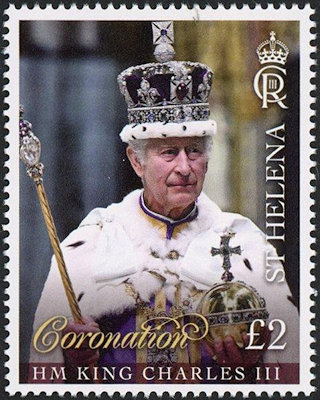
In England, we board the boat and sail south across the Atlantic Ocean. Along the way, we pass the Bailiwick Islands (now King Charles's Crown Estates), better known as Guernsey and Jersey, and we ignore the "rock" of Gibraltar. We'll come back to that another time.
Once we have sailed along the Spanish and Portugese islands, we meet the first BOT-island: Ascension.
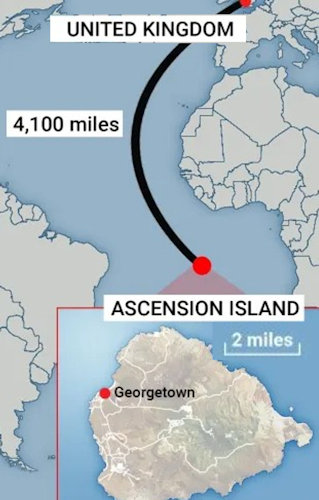
The island, first named "Concencion" (Immaculate Conception) by the Portuguese, was discovered in 1501. In 1503, the English seized the virtually uninhabited island and renamed it Ascension Day, after the day it was taken from Portugal. Today, approximately 800 people live on the island, which is only 88 km² in size. Important for us: there are no known motorcycle philatelic items from it.
If we then travel 1,800 km southeast, we land on the island of Saint Helena. Saint Helena is the main island of the Saint Helena archipelago, and on it is the capital of the archipelago: Jamestown.
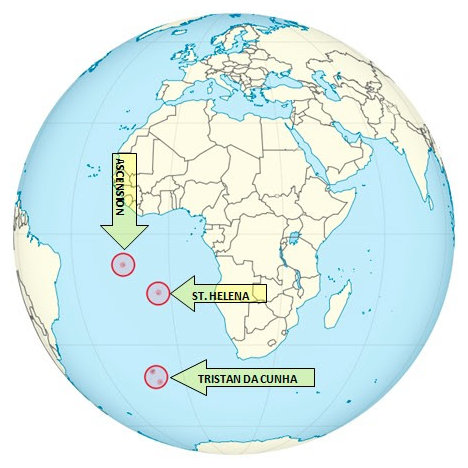
This island was discovered in 1502 by the Portuguese João da Nova on the feast day of Saint Helena. The Portuguese used it for provisions (fresh water and meat), without building a proper colony. But their discreet approach did not prevent the English from being interested.
After an attack by the White Lion in 1613 (the St. Helena Post Office dedicated a series of six stamps to this attack in 1978), the island was claimed by the Republic of the Seven United Netherlands.
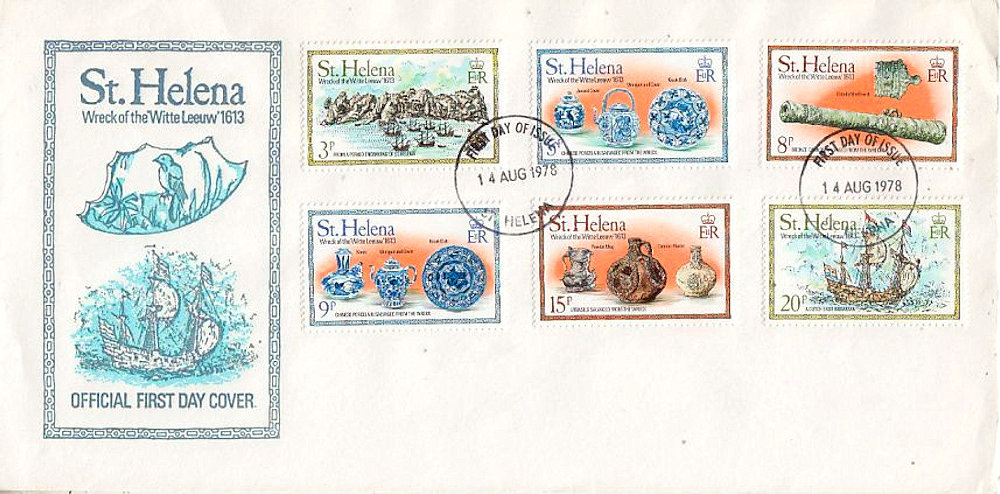
In 1658, the British East India Company founded Jamestown and took possession of the island. In 1673, the Dutch recaptured Saint Helena, but were expelled again by the British two months later. The island remained in British hands thereafter.
The St. Helena Islands are volcanic in origin, but the last eruption is estimated to have occurred 7 million years ago. Consequently, the highest point on the island, Diana's Peak, has now eroded to an elevation of 818 meters. The island is surrounded by numerous small islands and rocks, some 22 in total. The island covers approximately 122 km².
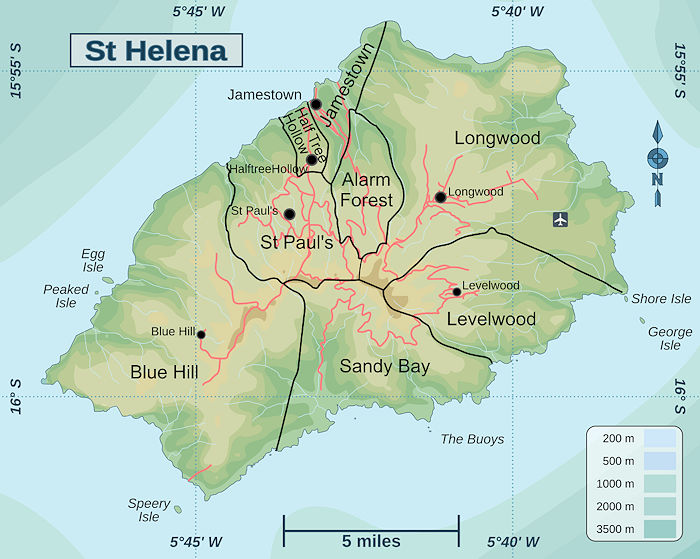
On the island a wide variety of animals is living: cattle, cats, dogs, donkeys, goats, mice, rabbits, rats, and sheep, brought as food for ships' crews.
The island has approximately 5,000 inhabitants, primarily descendants of people from Great Britain, colonists ("planters"), soldiers, and slaves.
For mail delivery on St Helena, you can use the local postal services. Postal services on St Helena, including local mail, are provided by the Post & Customer Services Centre. They are responsible for the collection, processing, and delivery of mail on the island. Once collected, the mail is distributed to private deliverers. These services began in 1965, and for this a special postmark and envelope were issued.
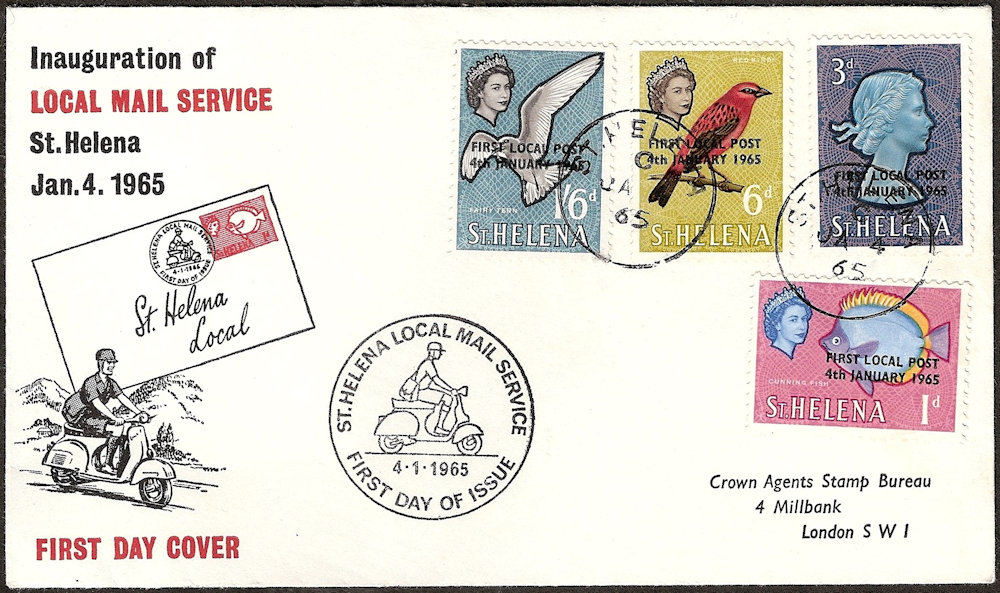
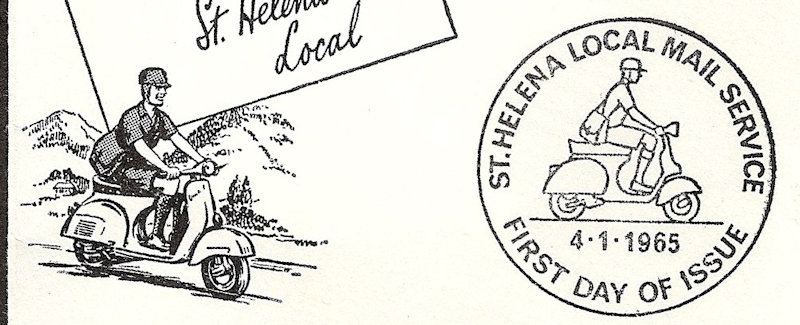
In addition to this special postmark, a local postmark was placed on the postage stamps. These include: H.T. Hollow, Blue Hill, New Ground, and St. Paul's 2. Envelopes issued by the St. Lucia Philatelic Service do not bear a place name in the regular postmark.
Postage must be paid using stamps from the island-wide postal service, which has also issued a number of motorcycle stamps and FDCs.
On 16 November 1991 the postal service issued a series of four stamps and a block to commemorate the 1991 International Stamp Exhibition "PHILA NIPPON '91" in Tokyo, Japan. These depict motorcycles used on the island and motorsports.
The stamps depict motorcycles against a background of characteristic island views. The block features motocross, a popular sport on the island and the third-largest in the country after football and cricket.
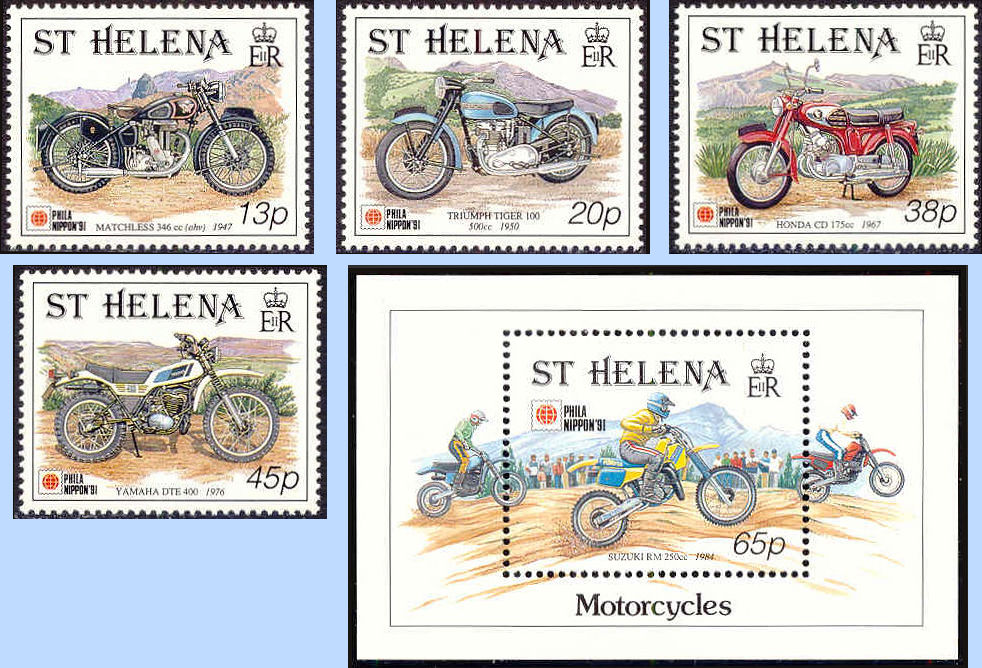
The St. Helena Moto-Cross Club organizes a national championship, where participants compete in four different classes: 125cc, 250cc, Open, and Junior, as well as for the annual "Robert Glanville Piston Cup" (named after the late Robert Glanville, a local motorcycle enthusiast). The club has been in existence since 1986 and operates from the motocross track at Bradley's (Longwood).
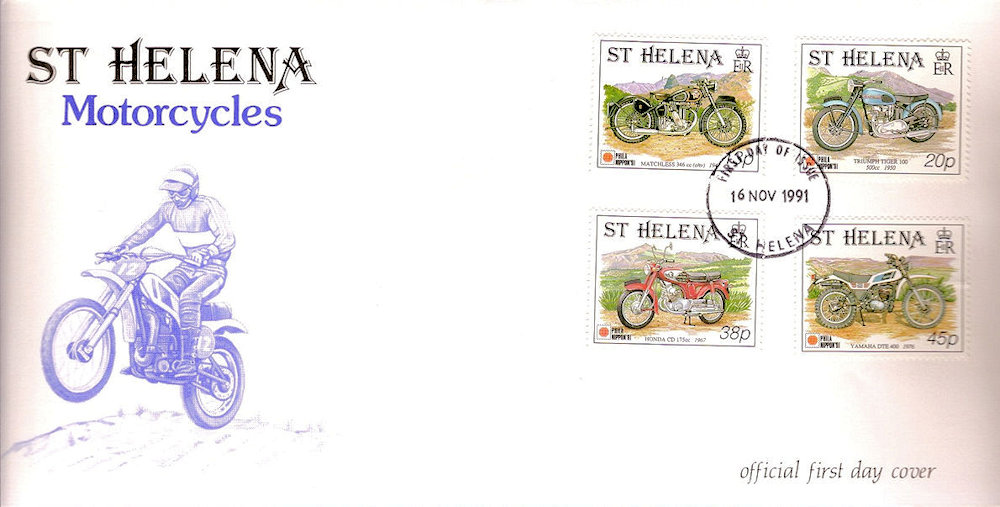
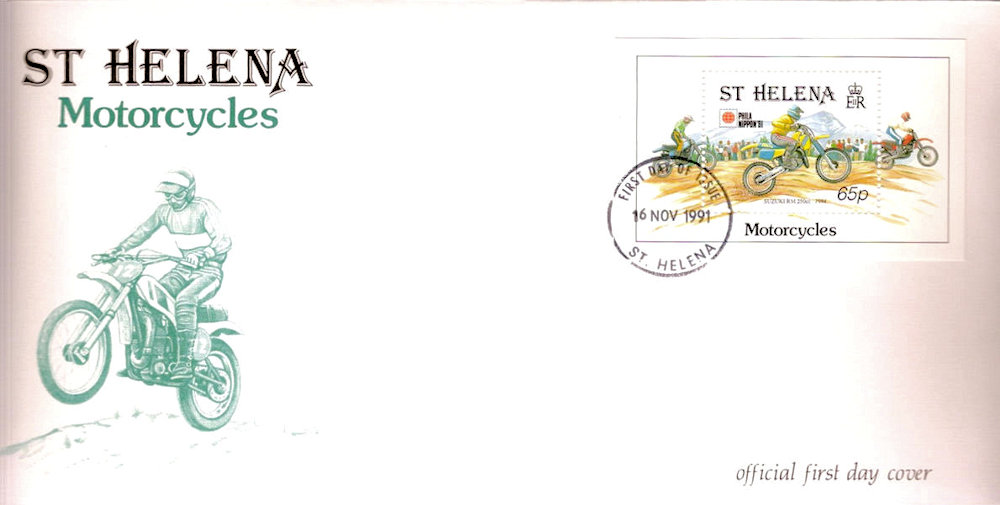
On 8 June 1996 a series of four stamps and a block was issued to commemorate the International Stamp Exhibition "CAPEX '96" in Toronto, Canada, showcasing various forms of mail transport to, from, and within St. Helena. Besides helicopters, ships, and airplanes, there was, of course, local delivery, carried out by delivery personnel on scooters. Below the stamp image, a reference is made to the "First Local Mail Delivery". Judging by the scooter body and headlight, it looks like a Lambretta to me.
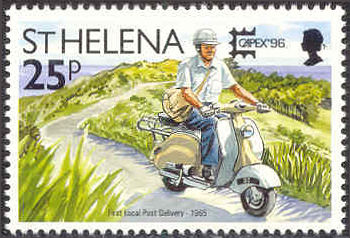
The nicely decorated FDC also features a scooter and the other modes of transportation shown on the stamps. The corresponding block features a train. Not interesting!
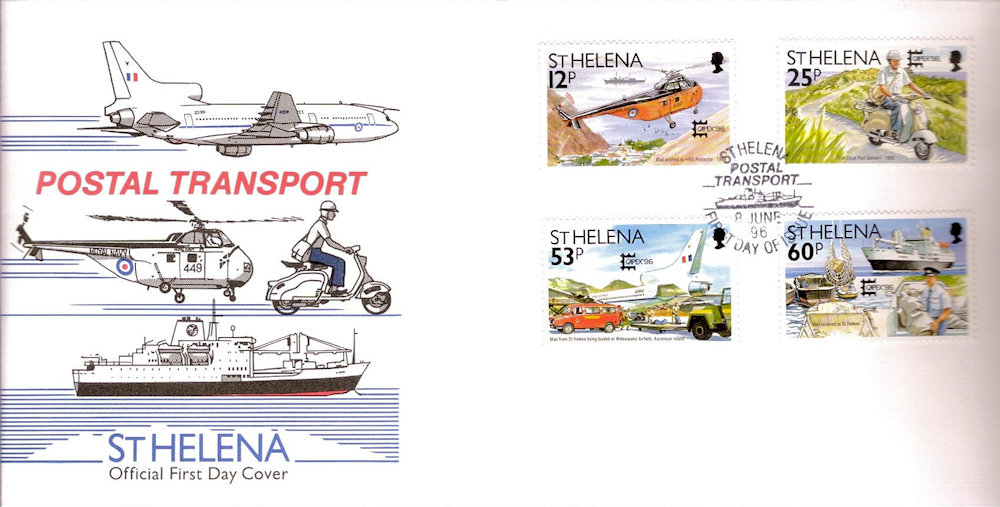
That's all I want to say about St. Helena so far, and from there we'll take the boat a bit further southwest to a small archipelago belonging to the Saint Lucia archipelago: Tristan da Cunha.
Tristan da Cunha is the main island of the archipelago of the same name. The archipelago consists of seven islands and islets: the aforementioned Tristan da Cunha, measuring 98 km², Gough, which measures 91 km², Inaccessible Island, which measures 14 km², and the Nightingale Islands, which in turn consist of the three islets Nightingale, measuring 1.8 km², and Middle and Stoltenhoff, each measuring less than 0.1 km². All of them, however, fall under the administration based in Edinburgh-of-the-Seven-Seas that is appointed by the Governor of St. Helena.
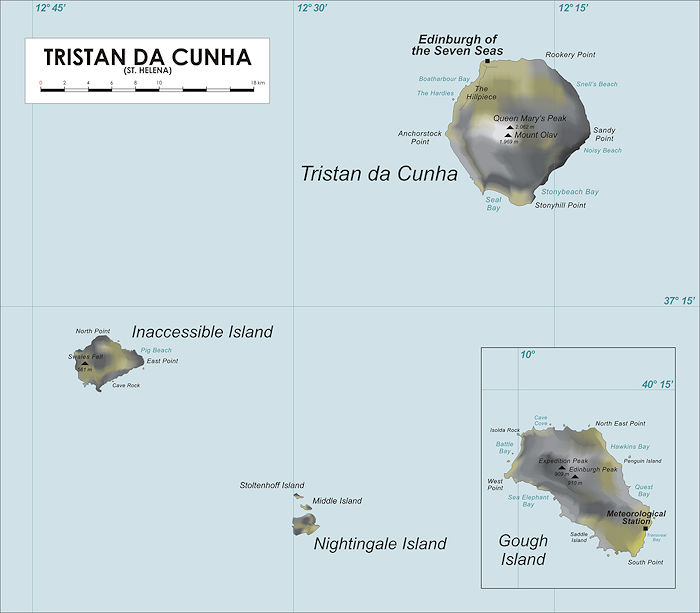
In 1506, the Portuguese admiral Tristão da Cunha discovered the archipelago in the South Atlantic Ocean, the largest and most impressive of which he named after himself: Tristan da Cunha. This archipelago is also of volcanic origin, and the extinct volcano measures 2,062 meters in height. The number of inhabitants living on the 1.4 km² of habitable land is 250. Six people live on Gough, bringing the total to 256.

The capital Edinburgh-of-the-Seven-Seas
The post office on Tristan da Cunha issues its own stamps, although the Saint (as you designate something or someone from St. Helena) and British stamps are also valid on the Tristan Islands. Initially, in 1952, these St. Helena stamps were overprinted, but by 1953, the Cunhaians got their own stamps.
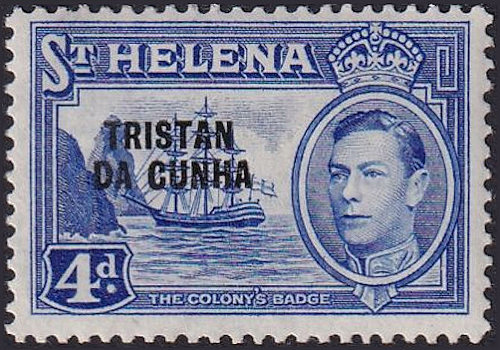
On 27 February 1995 a series of four stamps was issued, depicting local transport, featuring a Land Rover, a pickup truck, a van, and two delivery vehicles: a Yamaha off-roader and, of course, a scooter, likely for postal service. Owning a car is pointless, as the distances in the town are too short, and there's only one other road, just 4 km long.
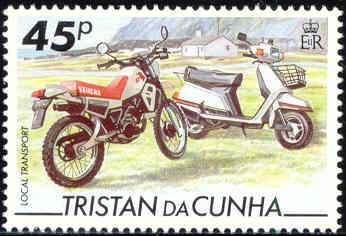
The motorcycle depicted on the stamp is a Yamaha DT 50, a model produced in the 1980s. Although the Tristan da Cunha stamp does not mention a specific year, the Yamaha DT 50 matches the description of a "Yamaha 50cc 1980". The scooter will also be a Yamaha, specifically the Yamaha Beluga 125 XC.
On the FDC of the complete series we are welcomed to "The loniest island of the world".
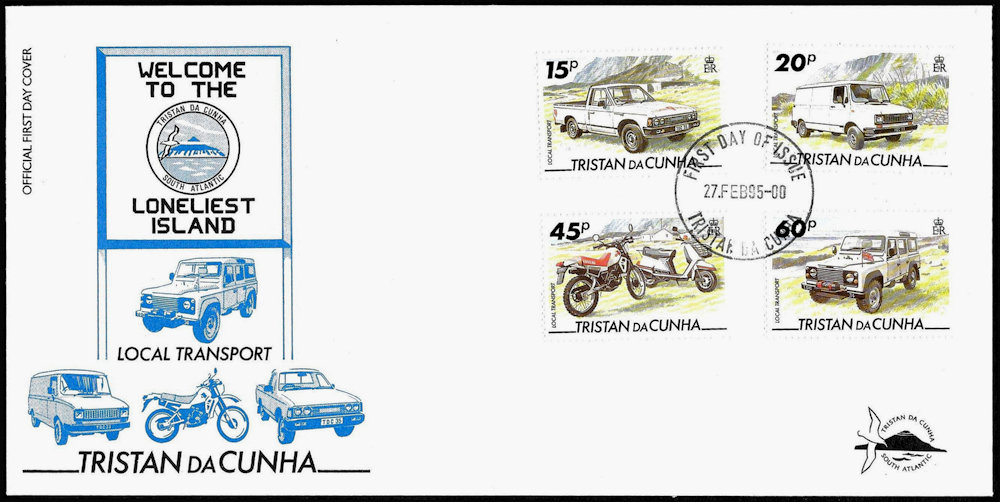
After visiting Saint Helena, we'll get back on the boat and head for the next BOT area(s). Let's set sail.
Hans de Kloet
Top - Back to former page - Home |